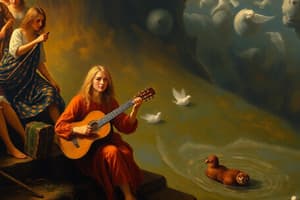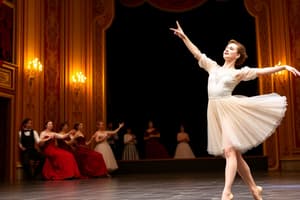Podcast
Questions and Answers
오페라의 기원은 다음 중 어디에서 비롯되었나요?
오페라의 기원은 다음 중 어디에서 비롯되었나요?
- 16세기 후반의 이탈리아
- 중세 시대의 성경 연극
- 르네상스 시대의 이탈리아
- 고대 그리스 드라마 (correct)
오페라의 구성 요소는 무엇입니까?
오페라의 구성 요소는 무엇입니까?
- 사회적 이벤트에 관련된 문항
- 음악적 셋팅을 위한 콩테스트
- 악기 반주를 갖춘 보컬 곡 (correct)
- 무대 연기
오페라의 역사는 얼마큼이나 되나요?
오페라의 역사는 얼마큼이나 되나요?
- 10000년
- 5000년
- 1000년
- 500년 (correct)
오페라의 원래 아이디어는 무엇이었습니까?
오페라의 원래 아이디어는 무엇이었습니까?
오페라가 다양한 예술분야를 결합하는 이유는 무엇입니까?
오페라가 다양한 예술분야를 결합하는 이유는 무엇입니까?
Dafne은 어떤 음악가에 의해 만들어졌습니까?
Dafne은 어떤 음악가에 의해 만들어졌습니까?
오페라의 역사는 언제 시작되었나요?
오페라의 역사는 언제 시작되었나요?
오페라집사는 어떤 공간을 포함하고 있습니까?
오페라집사는 어떤 공간을 포함하고 있습니까?
오페라의 종류 중 '클래식 오페라'는 어떤 특징을 가지고 있습니까?
오페라의 종류 중 '클래식 오페라'는 어떤 특징을 가지고 있습니까?
'오페레타' 작품은 어떤 특징을 가지고 있습니까?
'오페레타' 작품은 어떤 특징을 가지고 있습니까?
'오스터레토'에 대해 옳은 설명은 무엇입니까?
'오스터레토'에 대해 옳은 설명은 무엇입니까?
'싱스필'에 대한 설명 중 가장 올바른 것은 무엇입니까?
'싱스필'에 대한 설명 중 가장 올바른 것은 무엇입니까?
Flashcards are hidden until you start studying
Study Notes
Opera: A Multi-Disciplinary Art Form
Opera is a musical genre that combines various artistic disciplines, including singing, music, dance, theater, scenography, performance, costumes, makeup, hairdressing, and more. This multidisciplinary nature makes opera a work of collective creation, involving a librettist, composer, vocal performers, musicians, conductors, dancers, set and costume designers, and many other figures. It is also a social event, requiring an audience to witness the performance. The history of opera is relatively short, dating back to 1597, when the first opera, Dafne by Jacopo Peri, was created.
Origins of Opera
Opera originated in Italy during the late 16th century. Its roots can be traced back to the plays of ancient Greek dramatists Aeschylus, Sophocles, and Euripides, which combined poetic drama and music. During the Middle Ages, biblical dramas were chanted or interspersed with music. However, opera as we know it today emerged from the Renaissance's fascination with the ancient world of the Greeks and Romans. The original idea of opera was to recreate Greek drama, retaining the elements of tragedy such as plot, character, thought, language, spectacle, and music.
Components of Opera
Opera is a staged drama set to music in its entirety. It typically consists of vocal pieces with instrumental accompaniment. The librettist is responsible for putting the story or play into a form suitable for musical setting and singing. The composer then sets the libretto to music. The opera house is designed to accommodate a sizable stage, a large backstage area to house the scenery, a "pit" or space for an orchestra, and seating for a reasonably large audience.
Types of Opera
There are several types of opera, including:
- Classical opera: This is the traditional form of opera, characterized by grandeur, spectacle, and epic themes.
- Chamber opera: A more intimate and smaller-scale version of opera, often performed in smaller venues.
- Operetta: A light, comedic opera that typically features a simpler plot and more straightforward music.
- Musical: A type of opera that integrates music and dialogue more freely, similar to a play with music.
- Singspiel: A German genre that combines songs with spoken dialogue and a simpler plot.
- Zarzuela: A Spanish genre that combines elements of opera and musical theater, often with a comic plot.
Opera has also evolved over time, with different styles and genres emerging in response to changing tastes and societal influences. For example, the 18th century saw the development of opera seria and opera buffa, with opera seria focusing on serious, nobel characters and political intrigue, and opera buffa featuring ordinary characters and lighter topics. In the 19th century, opera became a means to express national identity, with composers such as Richard Wagner and Giuseppe Verdi writing operas that reflected the cultural and historical contexts of their respective countries.
History of Opera
The history of opera begins in 1597 with the creation of the first opera, Dafne by Jacopo Peri. In the early years, opera was enjoyed in the Italian and French royal palaces and was characterized by expensive productions designed to impress visiting dignitaries. The first recognizable opera, with the story told through song and music, was Orfeo by Monteverdi, first performed in Mantua in 1607.
Throughout its history, opera has evolved and adapted to changing societal and artistic trends. The 18th century saw an explosion of opera across Europe, with opera houses being built in major cities and new operas being commissioned for each season. The 19th century saw the rise of nationalism, with opera becoming a means to express national identity.
In the 20th century, opera began to adapt to new technologies and audiences, with the introduction of video and DVD recordings, cinematography, and high-definition simulcasts in movie theaters. These innovations have made opera more accessible to a larger audience and have changed the way composers, librettists, impresarios, and performers approach the genre.
In conclusion, opera is a complex and evolving art form that brings together various artistic disciplines and cultural influences. Its history is relatively short, but its impact on Western culture has been significant and enduring. From its roots in ancient Greek drama to its modern-day adaptations, opera continues to reflect and shape the societies in which it is produced.
Studying That Suits You
Use AI to generate personalized quizzes and flashcards to suit your learning preferences.




